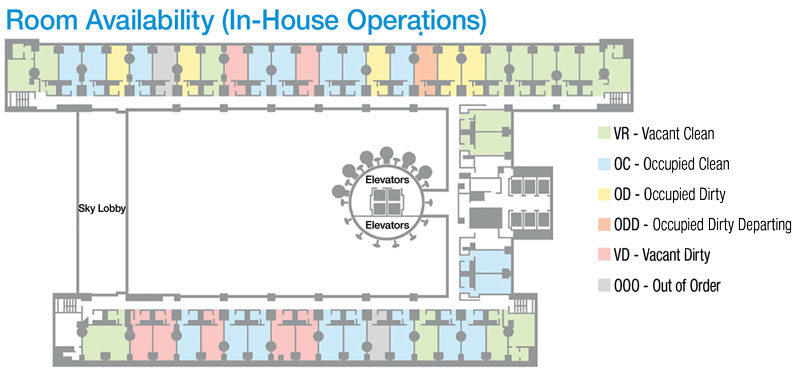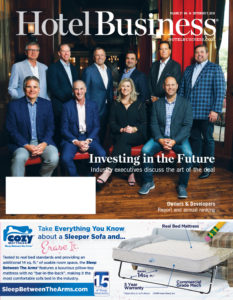BELLEVUE, WA—For guests and hotels alike, having a map handy can be a positive; maps provide guests with a better experience, while enabling employees to work more efficiently. But, like all innovations that have gone digital, a map is no longer just a means of wayfinding—digital mapping enables hotels to aggregate and use data to improve the experience.
When it comes to wayfinding, Jon Croy, co-founder and chief marketing officer, Point Inside, a provider of digital mapping and indoor location-based services, said that the size and complexity of a hotel are the most important factors in determining how confusing wayfinding can be for guests. At a four-story, select-service property, guests can easily find their way, but at a large resort with convention space and multiple F&B venues that’s set on several acres, this can be more difficult.
There’s also the factor that we, as a society, have come to expect maps. “People are used to searching for directions. I do it every day. Even though I know I only have option A and B to go to work, I’m still looking for my best options,” Croy said. “It’s a habit. That habit is slowly encroaching on the indoor space. If people are used to doing something for their approach to the hotel, they’re going to start getting more used to it for their navigation through the hotel.”
But, he added, that’s a good thing for hotels. “Just having a map in the hands of a user encourages interaction,” he said. “It’s a psychological thing: If you understand the space around you, you’re more likely to actually engage with it. When someone is engaged, they have a better, more memorable experience.”
On the operations side, he said, there are numerous benefits for hoteliers, starting with location-based operations. “We work with the operational teams—the cleaning crews—to visualize on a map those rooms that are checked out or not checked out—whether it’s checked out but not clean, checked out but not inspected, checked out, cleaned, and inspected, etc.,” he said. “Right now, that’s usually done over a piece of paper or an app with lines, but being able to see that on a map helps organize those tasks a bit better and makes those operations more efficient.”
He pointed to an app Point Inside created that handled numerous tasks for an in-venue operator. “How often do you walk by a cleaning crew and they’re good at saying, ‘Good morning?’ But what if the hotel was able to know they just shaved nine minutes per hour out of that person’s tasks because of the efficiencies they’re creating?” he asked. “We encouraged guest interaction, and then we would log that through the app. You have nine minutes out of your hour where you’re expected to engage with guests, more than a ‘Good morning’—ask if you can help them find something. We’d log those interactions, and invariably 80% of the questions were asking where’s the best place for coffee, can you recommend a restaurant, etc.”
Workers pressed a guest-interaction button to log what they were doing, and then helped the guest find their way by showing them the location through the app. Employees then asked if guests wanted a link to the map. “Now, an anonymous guest gave you their number and you’re sending the map link to download, or possibly the app, so you’re creating a feeling of warmth, but also creating a digital hook, so if that person downloads the app they become a little more loyal to you,” he said.
“The final advantage for a hotel is the intelligence you gather,” he continued. “As the guest is interacting with your maps, wherever they are—kiosks or in app—you are able to learn about your guest. Were they in their room or in the conference area when they searched for coffee, near the pool when they ordered a sandwich? All of those behaviors, across all of the different guests, can help the hotel develop digital marketing profiles and audiences that they can then map to the broader audience. It allows hotels to do more higher fidelity marketing and digital marketing efforts out to different groups.”
The data, he said, is so important. “The No. 1 thing people say is that they’re already on Google Maps, especially the larger resorts we talk to. My first question back to them is, ‘Great, what are you learning from that?’ Nothing,” Croy said. “Google doesn’t share anything about what people are searching for and how they found your property. For a hotel, you want to take control of your data and you want to own how your data is distributed.”
And that data can improve how a hotel operates. For example, Croy said, “Tons of resorts and hotels with a decent-sized piece of property want to let people order their drinks and have someone deliver it right to them. The phone provides that capability. You have a system that can take an order in, you know where the order originated from a location standpoint, and you can deliver it right to their phone. You can do a lot of efficiencies around food delivery and server management. You could retool the way you do that and possibly reduce staffing by a headcount or two. And every dollar matters when it comes down to margin. You hear about the minimum wage increase. If you have people going from $7 to $15, that’s almost doubling your headcount. If you can save even 5% or 10% or 20% of that on labor optimization…it might not create profit, but it’s defending profit.”
Croy acknowledged that as of yet, there’s no one killer use case for a digital map in the hospitality industry. “But if you have the map as a foundation, it’s like Legos, you can start to layer them on and realize value here and there,” he said. “We have one customer who has purchased our solution exclusively for space planning in their facilities management team. A side benefit is now they get to use the maps for wayfinding and guest utilization.”
In cases like those, he said, the company creates different versions of the maps for different users. “A good map is not overcrowded with information or details; it provides us the information we want at the level of detail we need,” he said. “In the facilities management use case, the map is very detailed, almost like a CAD drawing, because they need to know the location of all the beacons, the outlets. But the consumer doesn’t care about that so you want to suppress that information for them. They don’t need to know the hinges are on the left side of the door. You don’t want to overwhelm people with a map.”
Point Inside also makes sure its maps are spatially accurate so that the “blue dot” users are used to from Google Maps and Apple Maps works well inside the hotel building.
Croy noted that, since many hotels use legacy systems and have gone through a lot of integrations, sometimes a phased approach is best. “Let’s start with the simple stuff—a simple floor plan with simple points like the Starbucks or the restroom or the pool, and get people used to using it. Then, you can start to collect analytics about what they’re using it for, and you can then put programs in place that may be two to three years out, but which would allow for things like what rooms are available or other advanced information you want to provide,” he said. “A lot of what we do isn’t about technology, but what technology enables in terms of change.” HB


